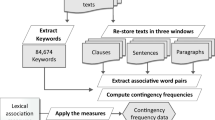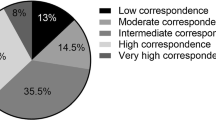Abstract
The 1-million-word Brown corpus was searched for co-occurrences of semantically related pairs of concrete nouns appearing within an arbitrary window of 250 characters. Related pairs of nouns (OCEAN-WATER) co-occur significantly more often than matched, unrelated pairs (OCEAN-HAND), and this difference remained significant within blocks of text up to 1000 characters in length. Frequency of co-occurrence, corrected for chance, is significantly correlated with association strength. Lexical distance between co-occurring members of a given pair is inversely correlated with association strength. Significantly more co-occurrences were found, per unit text, in the fictional sections of the corpus.
Similar content being viewed by others
References
Baars, B. J., & Motley, M. J. (1976). Spoonerisms as sequencer conflicts.American Journal of Psychology, 89, 467–484.
Bock, J. K. (1982). Toward a cognitive psychology of syntax: Information processing contributions to sentence formulation.Psychological Review, 89, 1–47.
Charles, W. G., & Miller, G. A. (1989). Contexts of antonymous adjectives.Applied Psycholinguistics, 10, 357–375.
Cramer, P. (1969).Word association. New York: Academic Press.
Deese, J. E. (1964). The associative structure of some common English adjectives.Journal of Verbal Learning and Verbal Behavior, 3, 347–357.
Handelman, S. A. (1985). Fragments of the rock: Contemporary literary theory and the study of Rabbinic texts—a response to David Stern.Prooftexts, 5, 75–103.
Justeson, J., & Katz, S. (1990). Co-occurrences of antonymous adjectives and their contexts.Computational Linguistics, 16.
Kelly, M. H., Bock, J. K., & Keil, F. C. (1986). Prototypicality in a linguistic context: Effect on sentence structure.Journal of Memory and Language, 25, 59–74.
Kucera, H., & Francis, W. N. (1967).Computational analysis of present-day American English. Providence: Brown University Press.
Motley, M. J., & Baars, B. J. (1976). Semantic bias effect on the outcome of verbal slips.Cognition, 4, 177–187.
Nisbett, R. E., & Wilson, T. D. (1977). Telling more than we can know: Verbal reports on mental processes.Psychological Review, 84, 231–259.
Palermo, D. S., & Jenkins, J. J. (1964).Word association norms: Grade school through college. Minneapolis: University of Minnesota Press.
Author information
Authors and Affiliations
Rights and permissions
About this article
Cite this article
Spence, D.P., Owens, K.C. Lexical co-occurrence and association strength. J Psycholinguist Res 19, 317–330 (1990). https://doi.org/10.1007/BF01074363
Accepted:
Issue Date:
DOI: https://doi.org/10.1007/BF01074363




